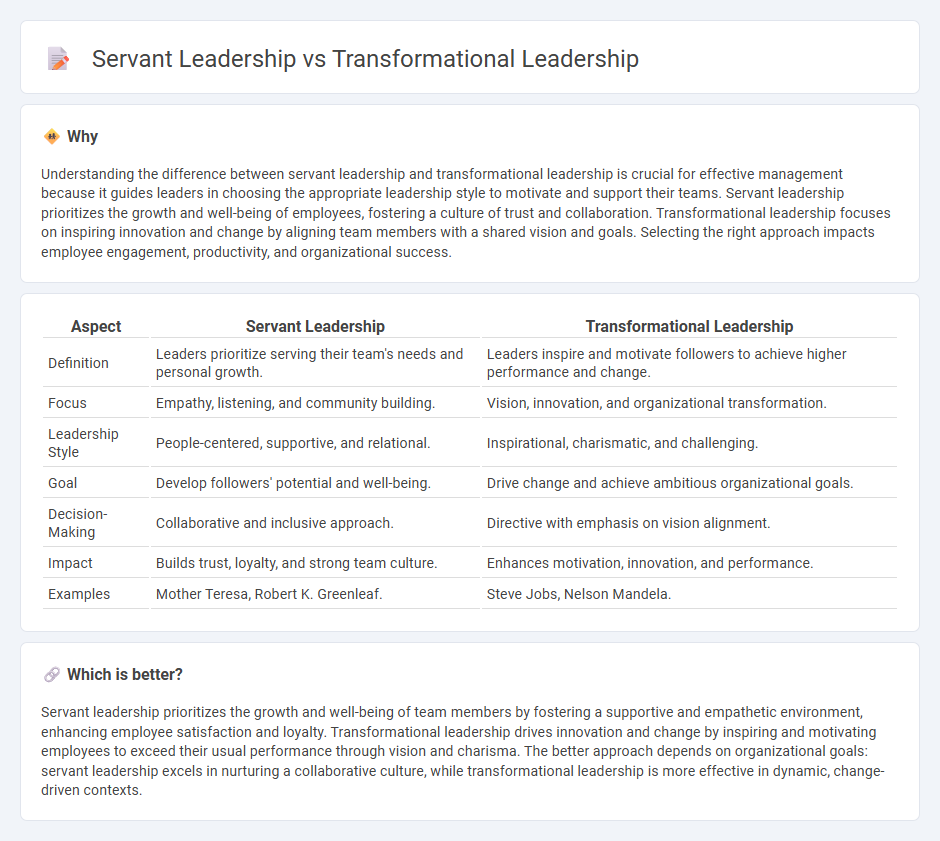
Servant leadership prioritizes the growth and well-being of team members, fostering collaboration and empathetic support to empower individuals. Transformational leadership focuses on inspiring and motivating employees to exceed expectations by creating a shared vision and driving organizational change. Discover how these leadership styles impact team dynamics and organizational success.
Why it is important
Understanding the difference between servant leadership and transformational leadership is crucial for effective management because it guides leaders in choosing the appropriate leadership style to motivate and support their teams. Servant leadership prioritizes the growth and well-being of employees, fostering a culture of trust and collaboration. Transformational leadership focuses on inspiring innovation and change by aligning team members with a shared vision and goals. Selecting the right approach impacts employee engagement, productivity, and organizational success.
Comparison Table
| Aspect | Servant Leadership | Transformational Leadership |
|---|---|---|
| Definition | Leaders prioritize serving their team's needs and personal growth. | Leaders inspire and motivate followers to achieve higher performance and change. |
| Focus | Empathy, listening, and community building. | Vision, innovation, and organizational transformation. |
| Leadership Style | People-centered, supportive, and relational. | Inspirational, charismatic, and challenging. |
| Goal | Develop followers' potential and well-being. | Drive change and achieve ambitious organizational goals. |
| Decision-Making | Collaborative and inclusive approach. | Directive with emphasis on vision alignment. |
| Impact | Builds trust, loyalty, and strong team culture. | Enhances motivation, innovation, and performance. |
| Examples | Mother Teresa, Robert K. Greenleaf. | Steve Jobs, Nelson Mandela. |
Which is better?
Servant leadership prioritizes the growth and well-being of team members by fostering a supportive and empathetic environment, enhancing employee satisfaction and loyalty. Transformational leadership drives innovation and change by inspiring and motivating employees to exceed their usual performance through vision and charisma. The better approach depends on organizational goals: servant leadership excels in nurturing a collaborative culture, while transformational leadership is more effective in dynamic, change-driven contexts.
Connection
Servant leadership and transformational leadership are connected through their shared focus on inspiring and empowering followers to achieve personal growth and organizational goals. Both leadership styles prioritize emotional intelligence, ethical behavior, and fostering a positive organizational culture that promotes collaboration and innovation. Research shows that integrating servant leadership's emphasis on serving others with transformational leadership's vision-driven approach enhances employee engagement and long-term performance.
Key Terms
Vision
Transformational leadership centers on inspiring a shared vision to drive innovation and long-term organizational change, emphasizing motivation and empowerment of followers. Servant leadership prioritizes serving the needs of others first, fostering a vision rooted in empathy, community, and personal growth. Discover the key differences in vision approach to determine which leadership style best suits your organizational goals.
Empowerment
Transformational leadership centers on inspiring and motivating followers to exceed expectations by fostering a shared vision and encouraging personal development, thereby boosting organizational performance. Servant leadership prioritizes the growth and well-being of team members by emphasizing empathy, stewardship, and the empowerment of individuals to achieve collective goals. Discover how empowerment functions differently within these leadership styles and its impact on team dynamics and success.
Service
Transformational leadership emphasizes inspiring and motivating followers toward a shared vision, driving innovation and change, while servant leadership prioritizes serving the needs of team members and fostering their personal growth to enhance overall well-being. Both leadership styles focus on service, but transformational leaders aim to elevate organizational performance through vision-driven influence, whereas servant leaders concentrate on empowering individuals through empathy and support. Discover the distinct impacts these leadership approaches have on team dynamics and organizational success.
Source and External Links
Transformational Leadership - Transformational leadership is a style that inspires and motivates employees to drive organizational success through innovation and collective commitment.
What Is Transformational Leadership? - Transformational leaders encourage, inspire, and motivate employees to create meaningful change through effective communication and adaptability.
Transformational Leadership - Transformational leadership involves behaviors that inspire followers to perform beyond expectations, focusing on idealized influence, inspirational motivation, individualized consideration, and intellectual stimulation.
 dowidth.com
dowidth.com